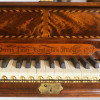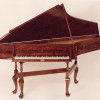- Other Forms
- Bentside Spinets
Bentside Spinets
Member Gallery
Address
Contact
Pair of Bentside Spinets reproduced after the John Harris spinets located at the Metropolitan Museum of Art. The pine and oak cases are veneered with figured mahogany panels set off from straight-grained mahogany banding by diagonal "barber- pole" inlay. An inlaid maple panel in the name battens above the keyboard reads "Steven M. Lash, Birmingham, Michigan, Fecit".
(Interesting notes regarding the spinets)
BENTSIDE SPINET #1
This musical instrument is a reproduction of the John Harris Spinet (1768) which is located in the Metropolitan Museum of Art in New York (#1976.229). It is one of a pair of spinets reproduced between 1981 and 1985. I designed the working portion of this instrument (See note 5). Bentside spinet #2 is a more faithful reproduction of the Harris spinet.
The pine and oak case is veneered with figured mahogany panels set off from straight-grained mahogany banding by diagonal "barber- pole" inlay. The jackrail and soundboard surround is also inlaid with this "barber pole" design. An inlaid maple panel in the name batten above the keyboard reads "Steven M. Lash, Birmingham, Michigan, Fecit". The soundboard is made of spruce and the wrestplank is of maple. The lid and front flap are of solid mahogany and secured by tulip-shaped strap and butterfly hinges. The brass hinges, lock, and hook are facsimiles of the originals and were made by Ball and Ball, Exton, Pennsylvania from rubbings made from the originals. The lid is finished with a molding below its edge that complements a similar molding around the lower edge of the case.
The keys are constructed of straight-grained pine, with the naturals covered with bone and the sharps in ebony. The arcades on the fronts of the keys are gold leafed. The jacks are made of pearwood with holly tongues. There is a lower guide as well as a box slide of individually chiseled cherry blocks. The oak nut and pearwood bridge are shaped like the originals. It has a shellac and wax finish.
The mahogany trestle stands with four baluster-turned supports squared to intersect horizontal braces terminate in cabriole legs with pad feet.
WOODS: Pine and oak case veneered with figured mahogany panels.
DIMENSIONS: H 33" x L 74 1/4" x D 30 1/4".
DATE: 1981-84
WHERE CONSTRUCTED: West Bloomfield and Birmingham, MI.
NOTES: 1. Photograph by Joni T. Strickfaden.
- I was permitted to measure the Harris spinet by Morrison Hecksher, Curator of American Decorative Arts at the Metropolitan Museum of Art
- I was also provided photographs of the spinet by Robert Sack of Israel Sack, Inc, the previous owner, and a prestigious New York antique dealer.
- There is a Latin inscription behind the jackrail which reads "Ingenium Nihil Est Praeter Naiorem Perseverantiae Habilitatem"--"Talent is nothing except a greater aptitude for patience".
- My first introduction to harpsichords was while watching Mr. Rogers' Neighborhood in my shop. I noted the name 'Hubbard and Dow' on the name batten. The next summer I visited their shop in Boston and started to research the instrument. I first saw the John Harris spinet in Israel Sack's 'American Antiques Vol. III . The MMA at first refused to allow me to measure the original Harris spinet so I designed my Bentside Spinet #1 using the measurements from a curators worksheet that I obtained from the Museum and from extensive personal research. (Prior to this time, I knew nothing about harpsichord making.) In addition, I spent time observing Mr. David Sutherland, a renouned harpsichord maker in Ann Arbor, MI. who reviewed my design of the working portion of the spinet including the string lengths, plucking points, jack construction, wrestpin and nut positions, etc. After construction of the carcase for bentside spinet #1 was completed, I did (finally) receive permission from the MMA to measure the original. I observed (to my chagrin) that the measurement of the spine of the spinet (overall length) was six inches greater than was documented in the measurements they sent me in the curator's worksheet. I therefore decided to build a second spinet using the more accurate measurements I made at the museum.
- July 1997: Thomas Ciul, a professional harpsichord and piano tuner replaced the strings, nut points, and plectra, and revoiced and retuned the instrument to improve the sound.
PROVENANCE:
- Featured at an exhibition of handmade musical instruments entitled "The Music Makers". Southeast Ohio Cultural Arts Center. The Dairy Barn, Athens, Ohio. October 1988.
- Exhibited and awarded the Blue Ribbon at American Woodworker's Magazine Woodworkers Show Gallery, Novi, MI. Prize was $1000
BENTSIDE SPINET #2
DESCRIPTION: (See description of Bentside Spinet #1) This spinet is identical to its pair except (1) it is six inches longer, (2) its spine is made of pine instead of oak, (3) the jackrail and soundboard surround are inlaid with a single light strip of holly veneer instead of the "barber pole" design, (4) the keys are covered with ivory instead of bone and the sharps are made of black stained holly instead of ebony. This spinet is a more faithful reproduction of the original Harris spinet that is located in the Metropolitan Museum of Art in New York.
WOODS: Pine and oak case veneered with figured mahogany panels.
DIMENSIONS: H 33 1/4 x L 79 1/4 " x D 30 1/4"
DATE: 1981-84
WHERE CONSTRUCTED: West Bloomfield and Birmingham, MI
NOTES: 1. Photographed by Joni T. Strickfaden
- There is a Latin inscription behind the jackrail which reads "Multi Mirantur, Pauci Sciunt"--"Many admire, few know".
PROVENANCE:
- Featured in Fine Woodworking's DESIGN BOOK FOUR.



